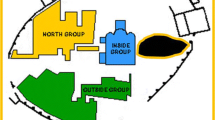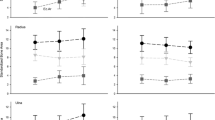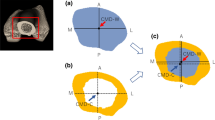Abstract
We studied the most complete skeletons found in an excavation from the 14th and 15th century in central Stockholm. One hundred eighty-seven were from men and 156 from women: 241 individuals were estimated to be between 20 and 39 and 102 between 40 and 59 years old at death. We examined the bones radiographically and by dual photon absorptiometry. The bone mineral density (BMD) was similar to the finding in North America and Northern Europe today as was the relationship between men and women. However, there appeared to be a higher diaphyseal bone density in the lower extremities, especially in men. The femur score was higher and the BMD of the femoral and tibial shafts was higher than today. In the upper extremities the diaphyseal bone density was lower. Meema's index, as well as the metacarpal score, was smaller than in individuals in this century and the BMD of the humeral shaft was also lower than seen today. Overall, the metaphyseal bone density was similar to what we now consider normal; i.e., the mean BMD of the femoral neck was 0.96 g/cm2 in men and 0.90 g/cm2 in women and of the distal radius 0.43 and 0.32 g/cm2, respectively. The low diaphyseal density and in the upper extremities may be related to the nutritional status, whereas the greater need for walking and standing in the 14th and 15th century might have led to the high diaphyseal density in the lower extremities. There was no evidence of bone loss after 40 years of age in either sex in our study. The average expected lifespan for an adult individual was less than 50 years and we suggest that the relatively high bone density in the older age group may be due to selection of the most physically fit. The activity pattern, therefore, may be considered the most important determinant for the differences.
Similar content being viewed by others
References
Krogman WM, Iscan YM (1986) The human skeleton in forensic medicine. Thomas Books, Springfield
Bass WM (1987) Human osteology, 3rd ed. Missouri Archeological Society, Columbia
Meema HE, Bunker MD, Meema S (1965) Loss of compact bone due to menopause. Obstet Gynecol 26:333–343
Barnett E, Nordin BEC (1960) The radiological diagnosis of osteoporosis. Clin Radiol 11:166–174
Trotter M, Gleser G (1958) A re-evaluation of estimation of stature based on measurements of stature taken during life and of long bones after death. Am J Physiol Anthrop 16:79–123
Trotter M, Gleser G (1952) Estimation of stature from long bones of American whites and Negroes. Am J Physiol Anthrop 10:463–514
Holmberg J (1952) The increase in the height of Swedish men and women from the middle of the 19th century up to 1930 and the changes in the height of the individual from the ages 26–70. Acta Med Scand 142(5):367–390
Smith RW Jr, Walker RR (1964) Femoral expansion in aging women: implications for osteoporosis and fractures. Science 145:156–157
Nordin BEC, MacGregor J, Smith DA (1966) The incidence of osteoporosis in normal women: its relation to age and the menopause. Q J Med 35:24–38
Mazess RB, Barden HS (1990) Interrelationships among bone densitometry sites in normal young women. Bone Miner 11: 347–356
Mazess RB, Barden HS, Drinka PJ, Bauwens SF, Orwoll ES, Bell NH (1990) Influence of age and body weight on spine and femur bone mineral density in U.S. white men. J Bone Miner Res 5:645–652
Kröger H, Heikkinen J, Laitinen K, Kotaniemi A (1992) Dualenergy x-ray absorptiometry in normal women: a cross-sectional study of 717 Finnish volunteers. Osteoporosis Int 2: 135–140
Liel Y, Edwards J, Shary J, Spicer K, Gordon L, Bell N (1988) J Clin Endocrinol Metab 66:1247–1250
Heinonen A, Pekka O, Kannus P, Sievanen H, Manttari A, Vuori I (1993) Bone mineral density of female athletes in different sports. Bone Miner 23:1–14
Runge H, Fengler F, Franke J, Koall W (1980) Ermittlung des peripheren Knochenmineralgehaltes bei Normalpersonen und Patienten mit verschiedenen Knochenerkrankungen, bestimmt mit Hilfe der Photonenabsorptionstechnik am radius. Radiologe 20:505–514
Lees B, Molleson T, Arnett TR, Stevenson JC (1993) Differences in proximal femur bone density over two centuries. Lancet 341:673–675
Author information
Authors and Affiliations
Rights and permissions
About this article
Cite this article
Ekenman, I., Eriksson, S.A.V. & Lindgren, J.U. Bone density in medieval skeletons. Calcif Tissue Int 56, 355–358 (1995). https://doi.org/10.1007/BF00301601
Received:
Accepted:
Issue Date:
DOI: https://doi.org/10.1007/BF00301601




